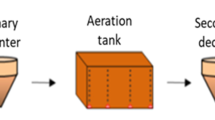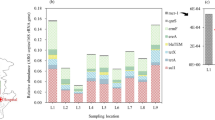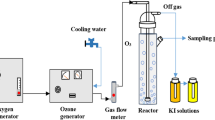Abstract
Antibiotic resistance genes (ARGs) pose a serious threat to public health. Wastewater treatment plants (WWTPs) are essential for controlling the release of ARGs into the environment. This study investigated ARG distribution at every step in the treatment process of a municipal WWTP located in Harbin for six consecutive months. Changes in ARG distribution involved in two advanced secondary effluent treatment processes, ozonation and granular activated carbon (GAC) adsorption, were analyzed. Biological treatment resulted in the highest ARG removal (0.76–1.94 log reduction), followed by ultraviolet (UV) disinfection (less than 0.5-log reduction). Primary treatment could not significantly remove ARGs. ARG removal efficiency increased with an increase in the ozone dose below 40 mg/L. However, amorphous GAC (AGAC) adsorption with a hydraulic retention time (HRT) of 1 h showed better removal of ARGs, total organic carbon (TOC), total nitrogen (TN), and total phosphorus (TP) than ozonation at a 60 mg/L dose. UV treatment could efficiently reduce the relative ARG abundance, despite presenting the lowest efficiency for the reduction of absolute ARG abundance compared with GAC and ozone treatments. The combination of ozone and AGAC can significantly improve the removal of ARGs, TOC, TN and TP. These results indicate that a treatment including biological processing, ozonation, and AGAC adsorption is a promising strategy for removing ARGs and refractory organic substances from sewage.

Similar content being viewed by others
References
Alexander J, Knopp G, Dötsch A, Wieland A, Schwartz T (2016). Ozone treatment of conditioned wastewater selects antibiotic resistance genes, opportunistic bacteria, and induce strong population shifts. Science of the Total Environment, 559: 103–112
Altmann J, Ruhl A S, Zietzschmann F, Jekel M (2014). Direct comparison of ozonation and adsorption onto powdered activated carbon for micropollutant removal in advanced wastewater treatment. Water Research, 55: 185–193
Auerbach E A, Seyfried E E, McMahon K D (2007). Tetracycline resistance genes in activated sludge wastewater treatment plants. Water Research, 41: 1143–1151
Bonvin F, Jost L, Randin L, Bonvin E, Kohn T (2016). Super-fine powdered activated carbon (SPAC) for efficient removal of micropollutants from wastewater treatment plant effluent. Water Research, 90: 90–99
Börjesson S, Melin S, Matussek A, Lindgren P (2009). A seasonal study of the mecA gene and Staphylococcus aureus including methicillin-resistant S. aureus in a municipal wastewater treatment plant. Water Research, 43: 925–932
Cataldo F (2006). DNA degradation with ozone. International Journal of Biological Macromolecules, 38: 248–254
Chang P H, Juhrend B, Olson T M, Marrs C F, Wigginton K R (2017). Degradation of extracellular antibiotic resistance genes with UV254 treatment. Environmental Science & Technology, 51(11): 6185–6192
Chen H, Zhang M (2013). Effects of advanced treatment systems on the removal of antibiotic resistance genes in wastewater treatment plants from Hangzhou, China. Environmental Science & Technology, 47: 8157–8163
Czekalski N, Imminger S, Salhi E, Veljkovic M, Kleffel K, Drissner D, Hammes F, Bürgmann H, Von Gunten U (2016). Inactivation of antibiotic resistant bacteria and resistance genes by ozone: From laboratory experiments to full-scale wastewater treatment. Environmental Science & Technology, 50: 11862–11871
Dietrich J P, Loge F J, Ginn T R, Başagaoglu H (2007). Inactivation of particle-associated microorganisms in wastewater disinfection: Modeling of ozone and chlorine reactive diffusive transport in polydispersed suspensions. Water Research, 41: 2189–2201
Dodd M C (2012). Potential impacts of disinfection processes on elimination and deactivation of antibiotic resistance genes during water and wastewater treatment. Journal of Envormental Monitoring, 14: 1754–1771
Gao P, Mao D, Luo Y, Wang L, Xu B, Xu L (2012a). Occurrence of sulfonamide and tetracycline-resistant bacteria and resistance genes in aquaculture environment. Water Research, 46: 2355–2364
Gao P, Munir M, Xagoraraki I (2012b). Correlation of tetracycline and sulfonamide antibiotics with corresponding resistance genes and resistant bacteria in a conventional municipal wastewater treatment plant. Science of the Total Environment, 421: 173–183
Golovko O, Kumar V, Fedorova G, Randak T, Grabic R (2014). Seasonal changes in antibiotics, antidepressants/psychiatric drugs, antihistamines and lipid regulators in a wastewater treatment plant. Chemosphere, 111: 418–426
Hollender J, Zimmermann S G, Koepke S, Krauss M, Mcardell C S, Ort C, Singer H, Von Gunten U, Siegrist H (2009). Elimination of organic micropollutants in a municipal wastewater treatment plant upgraded with a full-scale post-ozonation followed by sand filtration. Environmental Science & Technology, 43: 7862–7869
Huang J, Hu H, Tang F, Li Y, Lu S, Lu Y (2011). Inactivation and reactivation of antibiotic-resistant bacteria by chlorination in secondary effluents of a municipal wastewater treatment plant. Water Research, 45: 2775–2781
Jones C S, Osborne D J, Stanley J (1992). Enterobacterial tetracycline resistance in relation to plasmid incompatibility. Molecular and Cellular Probes, 6: 313–317
Kovalova L, Siegrist H, Von Gunten U, Eugster J, Hagenbuch M, Wittmer A, Moser R, McArdell C S (2013). Elimination of micropollutants during post-treatment of hospital wastewater with powdered activated carbon, ozone, and UV. Environmental Science & Technology, 47: 7899–7908
Lee J, Jeon J H, Shin J, Jang H M, Kim S, Song M S, Kim Y M (2017). Quantitative and qualitative changes in antibiotic resistance genes after passing through treatment processes in municipal wastewater treatment plants. Science of the Total Environment, 605: 906–914
Lin W, Li S, Zhang S, Yu X (2016). Reduction in horizontal transfer of conjugative plasmid by UV irradiation and low-level chlorination. Water Research, 91: 331–338
Luo Y, Mao D Q, Rysz M, Zhou D X, Zhang H J, Xu L, Alvarez P (2010). Trends in antibiotic resistance genes occurrence in the Haihe River, China. Environmental Science & Technology, 44(19SI): 7220–7225
Mao D, Luo Y, Mathieu J, Wang Q, Feng L, Mu Q, Feng C, Alvarez P (2013). Persistence of extracellular DNA in river sediment facilitates antibiotic resistance gene propagation. Environmental Science & Technology, 48: 71–78
Margot J, Kienle C, Magnet A, Weil M, Rossi L, De Alencastro L F, Abegglen C, Thonney D, Chèvre N, Schärer M (2013). Treatment of micropollutants in municipal wastewater: Ozone or powdered activated carbon? Science of the Total Environment, 461: 480–498
McKinney C W, Pruden A (2012). Ultraviolet disinfection of antibiotic resistant bacteria and their antibiotic resistance genes in water and wastewater. Environmental Science & Technology, 46: 13393–13400
Oh J, Salcedo D E, Medriano C A, Kim S (2014). Comparison of different disinfection processes in the effective removal of antibiotic-resistant bacteria and genes. Journal of Environmental Sciences (China), 26: 1238–1242
Osińska A, Harnisz M, Korzeniewska E (2016). Prevalence of plasmid-mediated multidrug resistance determinants in fluoroquinolone-resistant bacteria isolated from sewage and surface water. Environmental Science and Pollution Research International, 23: 10818–10831
Pei R, Cha J, Carlson K H, Pruden A (2007). Response of antibiotic resistance genes (ARG) to biological treatment in dairy lagoon water. Environmental Science & Technology, 41: 5108–5113
Rizzo L, Manaia C, Merlin C, Schwartz T, Dagot C, Ploy M C, Michael I, Fatta-Kassinos D (2013). Urban wastewater treatment plants as hotspots for antibiotic resistant bacteria and genes spread into the environment: A review. Science of the Total Environment, 447: 345–360
Rojas-Valencia M N (2011). Research on ozone application as disinfectant and action mechanisms on wastewater microorganisms. In: Mendez-Vilas A, Ed. Science Against Microbial Pathogens: Communicating Current Research and Technological Advances. Microbiology Book Series-Number 3, vol. 1. FORMATEX, Spain, 263–271
Sousa J M, Macedo G, Pedrosa M, Becerra-Castro C, Castro-Silva S, Pereira M F R, Silva A M, Nunes O C, Manaia C M (2017). Ozonation and UV254 nm radiation for the removal of microorganisms and antibiotic resistance genes from urban wastewater. Journal of Hazardous Materials, 323: 434–441
Sparbier K, Schubert S, Weller U, Boogen C, Kostrzewa M (2012). Matrix-assisted laser desorption ionization-time of flight mass spectrometry-based functional assay for rapid detection ofresistance against-lactam antibiotics. Journal of Clinical Microbiology, 50: 927–937
Stepanauskas R, Glenn T C, Jagoe C H, Tuckfield R C, Lindell A H, King C J, McArthur J V (2006). Coselection for microbial resistance to metals and antibiotics in freshwater microcosms. Environmental Microbiology, 8: 1510–1514
Szczepanowski R, Braun S, Riedel V, Schneiker S, Krahn I, Pühler A, Schlüter A (2005). The 120 592 bp IncF plasmid pRSB107 isolated from a sewage-treatment plant encodes nine different antibiotic-resistance determinants, two iron-acquisition systems and other putative virulence-associated functions. Microbiology, 151: 1095–1111
Wen Q, Yang L, Duan R, Chen Z (2016). Monitoring and evaluation of antibiotic resistance genes in four municipal wastewater treatment plants in Harbin, Northeast China. Environmental Pollution, 212: 34–40
Wen Q, Yang L, Zhao Y, Huang L, Chen Z (2018). Insight into effects of antibiotics on reactor performance and evolutions of antibiotic resistance genes and microbial community in a membrane reactor. Chemosphere, 197: 420–429
Zhai W, Yang F, Mao D, Luo Y (2016). Fate and removal of various antibiotic resistance genes in typical pharmaceutical wastewater treatment systems. Environmental Science and Pollution Research International, 23: 12030–12038
Zhang Y, Li A, Dai T, Li F, Xie H, Chen L, Wen D (2017). Cell-free DNA: A neglected source for antibiotic resistance genes spreading from WWTPs. Environmental Science & Technology, 52: 248–257
Zheng J, Su C, Zhou J, Xu L, Qian Y, Chen H (2017). Effects and mechanisms of ultraviolet, chlorination, and ozone disinfection on antibiotic resistance genes in secondary effluents of municipal wastewater treatment plants. Chemical Engineering Journal, 317: 309–316
Acknowledgements
The authors greatly appreciate the financial support from the National Key R&D Program of China (No. 2018YFC0406303), and the National & Local Joint Engineering Laboratory for Municipal Sewage Resource Utilization Technology, Suzhou University of Science and Technology (No. 2018KF06). The authors declare that there are no conflicts of interest.
Author information
Authors and Affiliations
Corresponding author
Additional information
Highlights
• The distributions of ARGs were monitored in a WWTP in Harbin during six months.
• CASS had the best removal efficacy of ARGs compared to other processes in the WWTP.
• UV disinfection could effectively control the HGT.
• AGAC significantly remove ARGs and organics due to its high absorption capacity.
• Combination of ozone and AGAC significantly improve removal of ARGs and organics.
Electronic Supplementary Material
11783_2019_1116_MOESM1_ESM.pdf
Impacts of advanced treatment processes on elimination of antibiotic resistance genes in a municipal wastewater treatment plant
Rights and permissions
About this article
Cite this article
Yang, L., Wen, Q., Chen, Z. et al. Impacts of advanced treatment processes on elimination of antibiotic resistance genes in a municipal wastewater treatment plant. Front. Environ. Sci. Eng. 13, 32 (2019). https://doi.org/10.1007/s11783-019-1116-5
Received:
Revised:
Accepted:
Published:
DOI: https://doi.org/10.1007/s11783-019-1116-5




